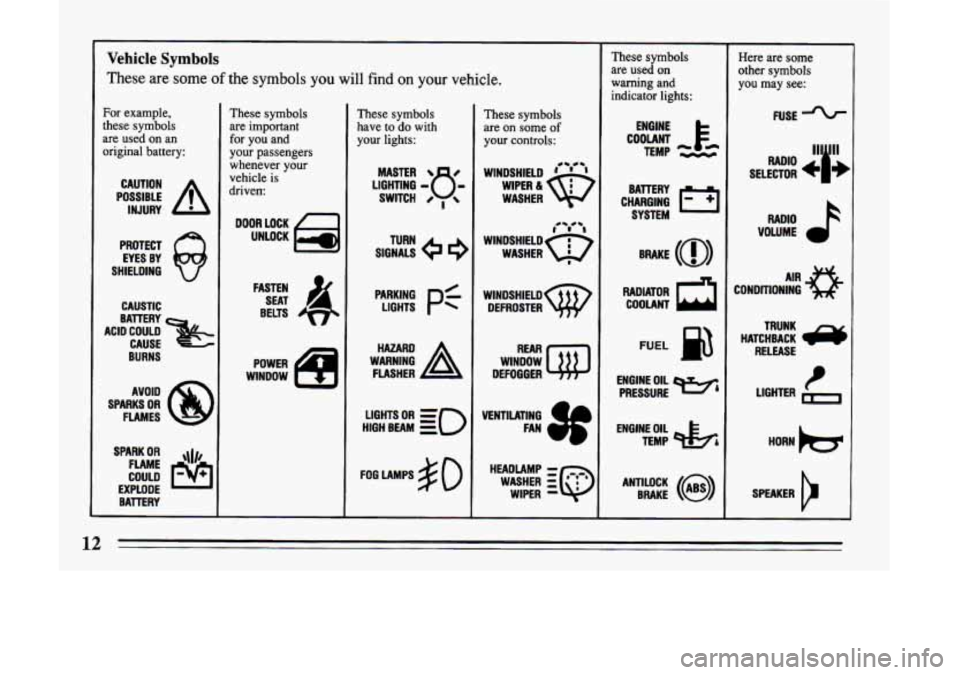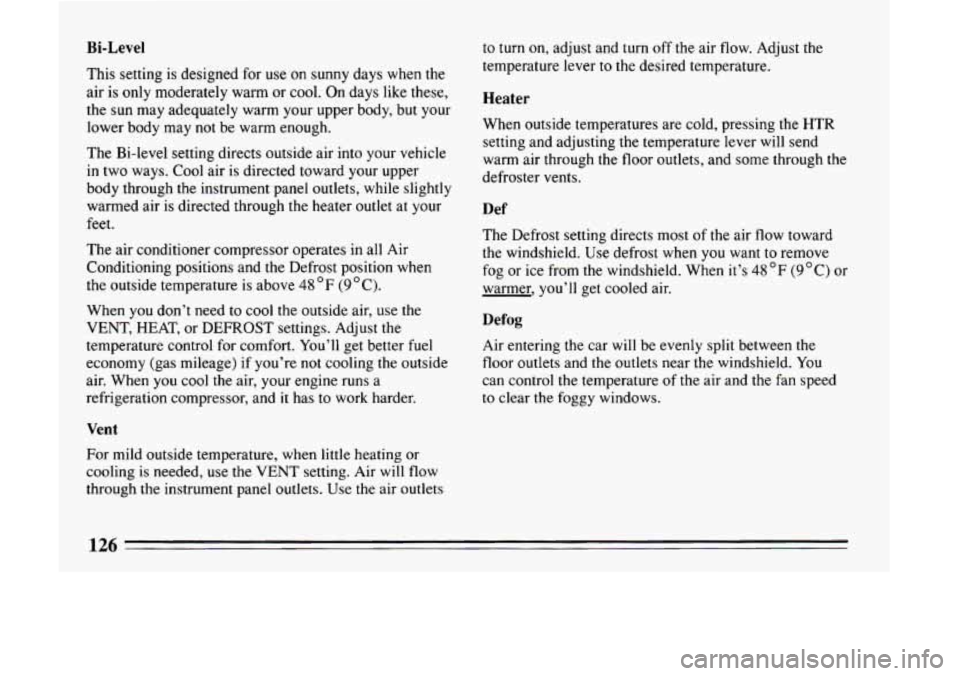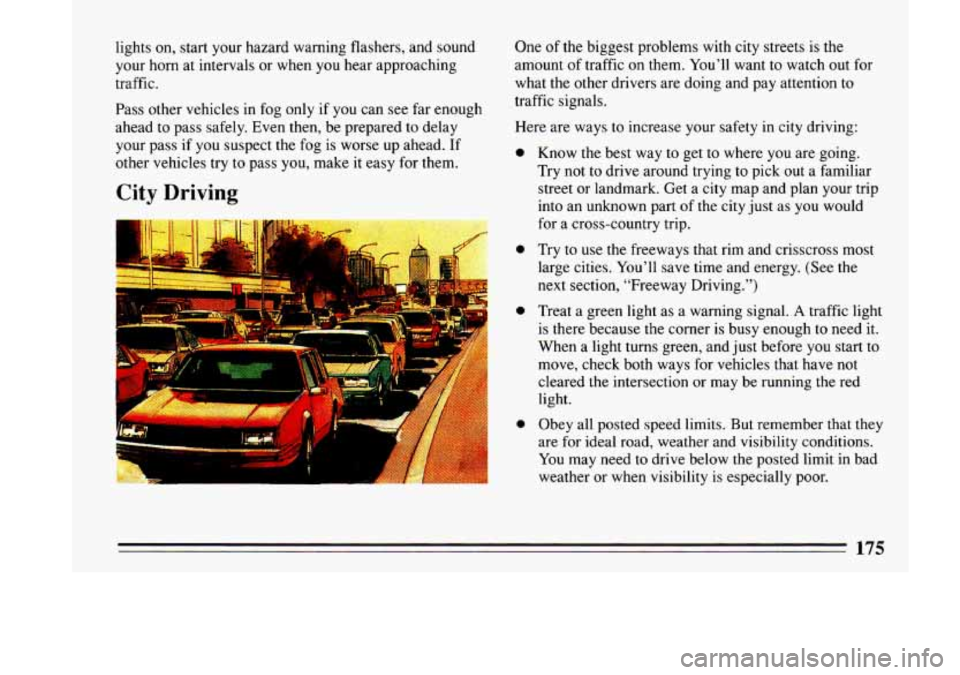1993 BUICK LESABRE fog light
[x] Cancel search: fog lightPage 14 of 324

Vehicle Symbols
These
are some of the symbols you will find on your vehicle.
For example,
these symbols
are used on an
original battery:
POSSIBLE A
CAUTION
INJURY
PROTECT EYES BY
SHIELDING
Q
CAUSTIC
BURNS AVOID
SPARKS
OR
FLAMES
SPARK
OR ,\I/,
COULD FLAME
EXPLODE BATTERY
These symbols
are important
for you and
your passengers
whenever your
vehicle is
driven
DOOR LOCK
UNLOCK
FASTEN SEAT
4
BELTS
WINDOW POWER
These symbols
have
to do with
your lights:
LIGHTING - 8 -
MASTER 8
SWITCH 0 ,
SIGNALS e 9
TURN
LIGHTS
Pf
HIGH BEAM OR = =o
FOG LAMPS # 0
These symbols
are on some
of
your controls:
WINDSHIELD ' ' ' 4- e-
WASHER
wlNDsHIELDw DEFROSTER
WINDOW
DEFOGGER
HEADLAMP
- r~.c.r
WASHER :Q
WIPER -
These symbols
are used on
warning and
indicator lights:
COOLANT F*
TEMP -.--
ENGINE
CHARGING
I-1
BATTERY SYSTEM
RADIATOR
a
COOLANT
FUEL
ENGINE OIL
PRESSURE
TEMP OIL
&
ANTILOCK (@)
BRAKE
Here are some
other symbols
you
may see:
FUSE
RADIO >
VOLUME
CONDITIONING
AIR 33
HATCHBACK /y
TRUNK
RELEASE
t LIGHTER
Page 88 of 324

A green arrow on the
instrument panel will flash
in the direction
of the turn
or lane change. If
you have
a trailer towing option with added wiring for
the trailer lights, a different turn signal flasher is used.
With this flasher installed, the signal indicator will flash
even if a turn signal bulb is burned out. Check the front
and rear
turn signal lights regularly to make sure they
are working.
Operation of Lights
To signal a lane change, just raise or lower the lever
until the green arrow starts to flash. Hold
it there until
you complete your lane change. The lever will return by
itself when you release it.
As you signal a turn or a lane change, if the arrows don’t
flash
but just stay on, a signal bulb may be burned out
and other drivers won’t see your turn signal.
If a bulb is burned out, replace it
to help avoid an
accident. If the green arrows don’t
go on at all when you
signal a turn; check the fuse (see “Fuses” in the Index)
and for burned-out bulbs. Although your vehicle’s lighting system
(headlamps,
parking lamps, fog lamps, side marker lamps and
taillamps) meet all applicable Federal lighting
requirements, certain States and Provinces may apply
their own lighting regulations that may require special
attention before you operate
these lamps. For example,
Page 89 of 324

some jurisdictions may require that you operate your
lower beam lamps with fog lamps at all times, or that
headlamps be turned on whenever you must
use your
windshield wipers.
In addition, most jurisdictions
prohibit driving solely with parking lamps, especially at
dawn or dusk. It
is recommended that you check with
you own State or Provincial highway authority for
applicable lighting regulations.
Headlight High-Low Beam
’ To change the headlights
from low beam to high or
high to low, pull the turn
signal lever all the way
toward you. Then release it.
When the high beams are
on, this blue light on the
instrument panel also will
be on.
Windshield Wipers
... ,rll
You control the windshield wipers by turning the band
marked “WIPER.”
For a single wiping cycle, turn the band to “MIST.”
Hold it there
until the wipers start, then let go. The
wipers will stop after one cycle. If you want more
cycles, hold the band
on “MIST” longer.
You can set the wiper speed for a long
or short delay
between wipes. This can be very
useful in light rain or
snow. Turn the band
to choose the delay time. The
closer to
“LO,” the shorter the delay.
87
Page 128 of 324

Bi-Level
This setting is designed for use on sunny days when the
air is only moderately warm or
cool. On days like these,
the sun may adequately warm your upper body, but your
lower body may
not be warm enough.
The Bi-level setting directs outside air into your vehicle
in two ways. Cool air is directed toward your upper
body through the instrument panel outlets, while slightly
warmed air is directed through the heater outlet at your
feet.
The air conditioner compressor operates in all Air
Conditioning positions and the Defrost position when
the outside temperature is above
48 OF (9OC).
When you don’t need to cool the outside air, use the
VENT, HEAT, or DEFROST settings. Adjust the
temperature control for comfort. You’ll get better fuel
economy (gas mileage) if you’re
not cooling the outside
air. When
you cool the air, your engine runs a
refrigeration compressor, and it has to work harder.
Vent
For mild outside temperature, when little heating or
cooling is needed, use the
VENT setting. Air will flow
through the instrument panel outlets. Use
the air outlets to
turn on, adjust and turn
off the air flow. Adjust the
temperature lever to the desired temperature.
Heater
When outside temperatures are cold, pressing the HTR
setting and adjusting the temperature lever
will send
warm air through the floor outlets, and some through the
defroster vents.
Def
The Defrost setting directs most of the air flow toward
the windshield. Use defrost when
you want to remove
fog or ice from
the windshield. When it’s 48 OF (9 “C) or
warmer, you’ll get cooled air.
Defog
Air entering the car will be evenly split between the
floor outlets and the outlets near the windshield. You
can control the temperature of the air and the fan speed
to clear the foggy windows.
126
Page 175 of 324

to pass -- or if you get hit by a gust of wind. You could
suddenly find yourself out of control.
Hydroplaning doesn’t happen often. But it can
ir your
tires haven’t much tread or if the pressure in one or
more is low.
It can happen if a lot of water is standing
on the road. If you can see reflections from trees,
telephone poles, or other vehicles, and raindrops
“dimple” the water’s surface, there could be
hydroplaning.
Hydroplaning usually happens at higher speeds. There
just isn’t a hard and fast rule about hydroplaning. The
best advice is to slow down.when it is raining, and be
careful.
Some Other Rainy Weather Tips
0 Turn on your headlights -- not just your parking
lights
-- to help make you more visible to others.
0 Look for hard-to-see vehicles coming from behind.
You may want to use your headlights even
in
daytime if it’s raining hard.
0 Besides slowing down, allow some extra following
distance. And be especially careful when you pass
another vehicle. Allow yourself more clear room
ahead, and be prepared to have your view restricted
bv road spray. If the road spray is so heavy you are actually blinded,
drop back. Don’t pass until
conditions improve. Going more slowly is better
than having an accident.
0 Use your defogger if it helps.
0 Have good tires with proper tread depth. (See
“Tires” in the Index.)
Driving in Fog, Mist and Haze
Page 176 of 324

Fog can occur with high humidity or heavy frost. It can
be so mild that you can see through it for several
hundred feet (meters). Or it might be
so thick that you
can see only a few feet (meters) ahead. It may come
suddenly to an otherwise clear road. And it can be a
major hazard.
When
you drive into a fog patch, your visibility will be
reduced quickly. The biggest dangers are striking the
vehicle ahead or being struck by the one behind. Try to
“read” the fog density down the road. If the vehicle
ahead starts to become less clear or, at night, if the
taillights are harder to see, the fog is probably
thickening. Slow down to give traffic behind you a
chance to slow down. Everybody then has a better
chance to avoid hitting the vehicle ahead.
A patch of dense fog may extend only for a few feet
(meters) or for miles (kilometers); you can’t really tell
while you’re in
it. You can only treat the situation with
extreme care.
One common fog condition
-- sometimes called mist or
ground fog
-- can happen in weather that seems perfect,
especially at night or in the early morning in valley and
low, marshy areas. You can be suddenly enveloped in
thick, wet haze that may even coat your windshield.
You
can often spot these fog patches or mist layers with your
headlights. But sometimes they can be waiting for
you
as you come over a hill or dip into a shallow valley.
Start your windshield wipers and washer, to help clear
accumulated road dirt. Slow down carefully.
Tips on Driving in Fog
If you get caught in fog, turn your headlights on low
beam, even in daytime. You’ll see
-- and be seen --
better.
Don’t use your high beams. The light will bounce
off the
water droplets that make up fog and reflect back at you.
Use your defogger. In high humidity, even a light
buildup of moisture
on the inside of the glass will cut
down on your already limited visibility. Run your
windshield wipers and washer occasionally. Moisture
can build up on the outside glass, and what seems
to be
fog may actually be moisture on the outside of your
windshield.
Treat dense fog as an emergency. Try to find a place
to
pull off the road. Of course you want to respect
another’s property, but you might need to put something
between
you and moving vehicles -- space, trees,
telephone poles, a private driveway, anything that
removes you from other traffic.
If visibility is near zero and you must stop but are
unsure whether you are away from the road, turn your
Page 177 of 324

lights on, start your hazard warning flashers, and sound
your horn at intervals or when you hear approaching
traffic.
Pass other vehicles in fog only if you can see far enough
ahead to pass safely. Even then, be prepared
to delay
your pass if you suspect the fog is worse up ahead. If
other vehicles try
to pass you, make it easy for them.
City Driving
I
One of the biggest problems with city streets is the
amount
of traffic on them. You’ll want to watch out for
what the other drivers are doing and pay attention to
traffic signals.
Here are ways
to increase your safety in city driving:
0
0
0
0
Know the best way to get to where you are going.
Try not to drive around trying to pick out a familiar
street or landmark. Get a city map and plan your trip
into an unknown part of the city just
as you would
for a cross-country trip.
Try
to use the freeways that rim and crisscross most
large cities. You’ll save time and energy. (See the
next section, “Freeway Driving.”)
Treat a green light as a warning signal.
A traffic light
is there because the corner is busy enough to need it.
When a light turns green, and just before you start to
move, check both ways for vehicles that have not
cleared
the intersection or may be running the red
light.
Obey all posted speed limits. But remember that they
are for ideal road, weather and visibility conditions.
You may need to drive below the posted limit in bad
weather or when visibility is especially poor.
Page 309 of 324

Weather Strips ................................ 266
White Sidewall Tires
........................... 266
Windshield and Wiper Blades
.................... 265
Comfort Control System
.......................... 11 8
Clock. Setting the
..................... 130.132.134. 137
Closed-In Places. Don't Idle in
...................... 81
COinYourExhaust
............................... 81
Color of Road Signs
.............................. 146
Comfort Control
& Audio Systems .................. 11 8
Compact Disc Care .............................. 142
Compact Spare Tire
.............................. 227
Contents. Table of
................................. 9
Control of
a Vehicle .............................. 158
Control.
Loss of ................................. 168
Controls. Features and
....... .- .................... 57
Convex Outside Mirror
.......................... ;" 100
Convenience Net ................................. 101
Coolant. Engine ................................. 243
Coolant. Engine. Warning Light
.................... 110
Coolant. Safety Warnings About
.................... 208
Covers.
How to Remove Wheel ...................... 21 8
Cruise Control ................................... 89
Cruise Control. Changing Speed With
................. 92
Cruise Control. Turning
Off ......................... 94
Cruise Control. Using on Hills
....................... 94
Curves. Driving
on ............................... 163
Customer Assistance Information
................... 297
Customer Satisfaction Procedure
.................... 297
Courtesy Lights
.................................. 97
.............................
8
(Drive) Third Gear 75
Automatic Overdrive
........................... 74
Damage to Finish
................................ 267 Damage to Sheet Metal
.......................... .26
7.
Damagewarnings
................................ 11
Daytime Running Lights ........................... 98
Dead Battery. What to Do
......................... 198
Defensive Driving
............................... 154
Defogger.
Rear Window ...................... 124. 127
Defogging
................................. 123. 126
Defrost
.................................... 124. 126
Delco Sound Systems
............................ 127
Dimensions
.................................... 273
Disc Brake Wear Indicators
......................... 162
Disposal. Used Oil
............................... 240
Door Locks
...................................... 59
Downhill Parking
................................ 182
Downshifting
.................................... 75
Driving
AtNight
.................................... 169
Defensively
.................................. 154
Drunk
...................................... 155
In a Foreign Country
........................... 232
In Cities
..................................... 175
In Fog. Mist or Haze ........................... 173
InRain
..................................... 171
In Winter
.................................... 185
On a Long Trip
............................... 178
On Freeways
................................. 176
On Curves
................................... 163
On Hill and Mountain Roads
.................... 180
On Snow or Ice
............................... 186
Through Deep Standing Water
.................... 71
DrunkenDriving
................................ 155
Dual Automatic ComforTemp Climate Control
......... 119
307
.